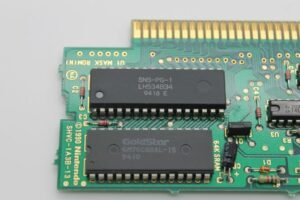Tesla Gigafactory
The Tesla Gigafactory is a state-of-the-art manufacturing facility designed to produce electric vehicle batteries and powertrains. It was established by Tesla, Inc. to meet the growing demand for sustainable transportation and energy storage solutions. Located in various parts of the world, including Nevada, Shanghai, Berlin, and Texas, the Gigafactory plays a crucial role in advancing Tesla’s mission of accelerating the world’s transition to sustainable energy.
Key Takeaways
- Built to produce electric vehicle batteries and powertrains.
- Multiple locations worldwide: Nevada, Shanghai, Berlin, and Texas.
- Supports Tesla’s mission of sustainable energy.
**The Gigafactory is divided into different sections, each dedicated to a specific part of the manufacturing process.** For instance, the Gigafactory in Nevada, known as Gigafactory 1, primarily focuses on battery production. Covering an area of approximately 1.9 million square feet, it is one of the largest buildings in the world and is powered by renewable energy sources. *Gigafactory 1 is capable of producing more lithium-ion batteries annually than were produced worldwide in 2013, allowing Tesla to significantly increase its electric vehicle production capacity.*
**Tesla’s Gigafactory in Shanghai, China, serves as a major hub for electric vehicle production and delivery in the Asian market.** It is the first Gigafactory built outside the United States and is instrumental in Tesla’s strategy to expand its global footprint. Located in Lingang, Shanghai, the Gigafactory is equipped with advanced manufacturing systems to ensure efficient production while maintaining high-quality standards. *The facility plays a crucial role in meeting the rising demand for electric vehicles in China, the world’s largest automotive market.*
| Location | Area | Production Capacity |
|---|---|---|
| Nevada, USA (Gigafactory 1) | 1.9 million sq ft | 35 GWh/year (batteries) |
| Shanghai, China | 210 acres | up to 500,000 vehicles/year |
| Berlin, Germany | 300 hectares | TBD |
**As part of its global expansion plans, Tesla is constructing a Gigafactory in Berlin, Germany.** This facility will focus on manufacturing batteries, powertrains, and vehicles, offering an integrated approach to production. With a planned area of over 300 hectares, the Berlin Gigafactory is expected to become one of the most advanced automotive manufacturing plants in the world. *The facility will create job opportunities, contribute to the local economy, and enhance Tesla’s ability to cater to the European market with faster delivery times.*
Gigafactory Statistics
- Tesla’s Gigafactory 1 in Nevada produced over 500,000 battery packs in 2020 alone.
- The Gigafactory in Shanghai can produce 3,000 electric cars per week, significantly boosting Tesla’s output.
- The Gigafactories collectively employ thousands of workers worldwide, supporting job creation and local economies.
| Location | Number of Employees | Opening Year |
|---|---|---|
| Nevada, USA (Gigafactory 1) | 7,000+ | 2016 |
| Shanghai, China | 6,000+ | 2019 |
| Berlin, Germany | To be determined | 2022 (estimated) |
**Tesla’s Gigafactory in Texas, USA, is under construction and will be dedicated to the production of the Tesla Cybertruck, Model Y, and other models.** This Gigafactory will include an onsite battery cell production facility, further streamlining the manufacturing process and reducing logistics costs. *The Texas Gigafactory is expected to have a significant impact on the regional economy and support Tesla’s expansion in North America.*
Gigafactory Timeline
- 2014: Tesla announces plans for Gigafactory 1 in Nevada.
- 2016: Gigafactory 1 begins battery cell production.
- 2019: Gigafactory in Shanghai commences operations.
- 2020: Gigafactory 1 expands to facilitate Model 3 production.
- 2022: Gigafactory in Berlin scheduled to commence operations.
- Ongoing: Gigafactory in Texas under construction.
| Year | Milestone |
|---|---|
| 2014 | Tesla announces plans for Gigafactory 1 in Nevada |
| 2016 | Gigafactory 1 begins battery cell production |
| 2019 | Gigafactory in Shanghai commences operations |
| 2020 | Gigafactory 1 expands to facilitate Model 3 production |
| 2022 | Gigafactory in Berlin scheduled to commence operations |
| Ongoing | Gigafactory in Texas under construction |
In conclusion, the Tesla Gigafactories worldwide represent a significant step forward in the acceleration of sustainable energy and electric vehicle production. *These advanced manufacturing facilities enable Tesla to meet the increasing demand for electric vehicles and batteries while creating employment opportunities and driving innovation in the automotive industry.* With further expansion plans on the horizon, Tesla’s Gigafactories will continue to shape the future of transportation and energy storage.

Common Misconceptions
Misconception 1: Tesla Gigafactory is the largest factory in the world
One common misconception about the Tesla Gigafactory is that it is the largest factory in the world. While it is indeed an impressive factory, it is important to note that there are other factories around the world that are much larger.
- The Boeing Everett Factory in Washington is currently the largest building in the world by volume.
- The Volkswagen factory in Wolfsburg, Germany, is also larger than the Tesla Gigafactory.
- China’s manufacturing facilities, such as the Great Wall Motors factory, are known for their massive scale.
Misconception 2: Tesla Gigafactory only produces electric vehicles
Another misconception is that the Tesla Gigafactory solely focuses on the production of electric vehicles. While electric vehicles are a significant part of Tesla’s manufacturing operations, the Gigafactory is responsible for the production of various energy products.
- The Gigafactory manufactures batteries and energy storage systems used in homes and businesses.
- Production of solar panels and solar roof tiles also takes place at the Gigafactory.
- Tesla’s energy products support the company’s mission of accelerating the world’s transition to sustainable energy.
Misconception 3: The Tesla Gigafactory is fully automated
Many people mistakenly believe that the Tesla Gigafactory is a fully automated facility with minimal human involvement. However, the reality is that the Gigafactory combines advanced robotic systems with skilled workers to achieve its production goals.
- Automation is used in various stages of production, including battery cell manufacturing and vehicle assembly.
- Skilled technicians and engineers play a crucial role in operating and maintaining the complex machinery and systems.
- Tesla emphasizes the importance of human expertise to ensure product quality and efficiency.
Misconception 4: The Tesla Gigafactory is self-sufficient in terms of energy
While the Tesla Gigafactory is often associated with sustainable energy practices, it is not completely self-sufficient in terms of energy consumption. Although efforts have been made to reduce reliance on the grid, the factory still relies on external sources for its power needs.
- The Gigafactory incorporates renewable energy sources, such as solar panels and wind turbines, to supplement its power requirements.
- Tesla has made efforts to minimize the carbon footprint associated with its operations by implementing energy-saving measures.
- Despite these initiatives, the Gigafactory is not entirely energy-independent.
Misconception 5: The Tesla Gigafactory is solely owned by Tesla
Contrary to popular belief, the Tesla Gigafactory is not solely owned by Tesla. While Tesla is the primary operator and majority owner of the facility, there are other partners and stakeholders involved in its creation and operation.
- Panasonic, a leading battery manufacturer, has a joint venture with Tesla in the Gigafactory.
- Other suppliers and companies are also involved in various aspects of the manufacturing processes.
- The Gigafactory represents a collaborative effort and strategic partnerships within the industry.

Tesla Gigafactory
The Tesla Gigafactory is a massive manufacturing facility owned by Tesla, Inc. It is located in Nevada, USA, and covers an area of 5.3 million square feet. The Gigafactory plays a crucial role in Tesla’s goal to produce electric vehicles and sustainable energy products at scale. Let’s explore some interesting data about this state-of-the-art facility.
Gigafactory Production Statistics
Here are some impressive production statistics from the Tesla Gigafactory:
| Production Metric | Value |
|---|---|
| Annual Battery Capacity | 35 gigawatt-hours |
| Number of Lithium-ion Batteries Produced Daily | over 3,000 |
| Number of Electric Vehicles Produced Daily | over 1,000 |
Energy Usage at the Gigafactory
The Gigafactory aims to be as energy-efficient as possible. Check out these fascinating figures related to its energy usage:
| Energy Usage | Amount |
|---|---|
| Total Annual Energy Consumption | 4.9 million megawatt-hours |
| Energy Consumption per Square Foot | 92 kilowatt-hours |
| Percentage of Renewable Energy | 100% |
Workforce and Employment
The Gigafactory provides substantial employment opportunities. Here’s some information about the workforce at the facility:
| Workforce Statistics | Number |
|---|---|
| Total Employees | 13,000+ |
| Percentage of Local Workforce | 70% |
| Additional Jobs Created in the Local Economy | 20,000+ |
Sustainability Initiatives
The Gigafactory strives to incorporate sustainability into its operations. Here are some noteworthy sustainability initiatives:
| Sustainability Aspect | Efforts |
|---|---|
| Waste Reduction | Over 90% of waste recycled or reused |
| Water Conservation | Water recycling systems reduce freshwater usage by 80% |
| Solar Power Generation | 70,000 solar panels on the roof |
Gigafactory Size Comparison
The Tesla Gigafactory is known for its massive scale. Let’s put its size into perspective:
| Size Comparison | Measurement |
|---|---|
| Gigafactory Footprint Area | 5.3 million square feet |
| Equivalent to | 107 American football fields |
| Building Volume | 13.6 million cubic meters |
Environmental Impact Reduction
The Gigafactory aims to minimize its environmental impact as much as possible. Here’s how it contributes to reduction:
| Reduction Measures | Result |
|---|---|
| CO2 Emissions Reduction | 240,000 metric tons annually |
| Fossil Fuel Consumption Reduction | 23 million gallons per year |
| Air Pollution Reduction | 62% decrease due to renewable energy usage |
Collaborations and Suppliers
The Gigafactory collaborates with numerous suppliers to ensure smooth operations. Here are some key collaboration details:
| Collaboration | Details |
|---|---|
| Main Battery Supplier | Panasonic Corporation |
| Partnership for Solar Power | SolarCity Corporation |
| Water Treatment Solutions Provider | Veolia Water Technologies |
Transportation Logistics
Efficient transportation logistics are crucial for the Gigafactory’s success. Here’s an overview of transportation data:
| Transportation Data | Information |
|---|---|
| Freight Rail Connection | Direct access to Union Pacific railroad |
| On-Site Parking Spaces | Over 10,000 |
| Electric Vehicle Chargers | 300+ |
In conclusion, the Tesla Gigafactory is an extraordinary facility driving Tesla’s mission to accelerate the world’s transition to sustainable energy. Through its impressive production metrics, sustainable practices, large-scale operations, and collaborations, it continues to establish itself as a landmark in the clean energy manufacturing industry.
Frequently Asked Questions
What is the Tesla Gigafactory?
The Tesla Gigafactory is a large-scale lithium-ion battery factory owned and operated by electric vehicle manufacturer Tesla, Inc. It is designed to produce battery cells, battery packs, and electric vehicle components.
Where is the Tesla Gigafactory located?
The Tesla Gigafactory is located in Sparks, Nevada, United States.
What is the purpose of the Gigafactory?
The primary purpose of the Tesla Gigafactory is to manufacture batteries at a large scale for Tesla vehicles, including models like the Model 3, Model S, and Model X. The factory also aims to reduce the cost of batteries and accelerate the adoption of sustainable transportation.
How big is the Tesla Gigafactory?
The Tesla Gigafactory is an enormous facility covering about 5.3 million square feet. It has multiple levels and an expansive footprint, making it one of the largest buildings in the world by square footage.
How many Gigafactories does Tesla have?
As of now, Tesla operates several Gigafactories around the world, including Gigafactories in Nevada, Shanghai (China), and Berlin (Germany). They continue to expand their manufacturing capabilities to cater to the growing demand for electric vehicles.
What is the production capacity of the Tesla Gigafactory?
The current production capacity of the Tesla Gigafactory in Nevada is estimated to be around 35 gigawatt-hours (GWh) per year. However, with ongoing expansions and advancements in battery technology, Tesla aims to significantly increase this capacity in the future.
How does the Gigafactory benefit the environment?
The Tesla Gigafactory focuses on sustainable practices and the use of renewable energy sources. It aims to reduce carbon emissions and minimize the environmental impact of battery production. With its green energy initiatives, it helps in the transition to a cleaner and more sustainable energy system.
Can the public visit the Tesla Gigafactory?
Unfortunately, the Tesla Gigafactory is not open for public tours or visits due to safety and operational reasons. Only authorized personnel and invited guests are allowed inside the facility.
What job opportunities are available at the Tesla Gigafactory?
The Tesla Gigafactory offers a wide range of job opportunities, including positions in manufacturing, engineering, research and development, logistics, and more. Interested individuals can visit the Tesla careers website to explore available positions and apply online.
How can I learn more about the Tesla Gigafactory?
For more information about the Tesla Gigafactory, its latest updates, and specific details, you can visit the official Tesla website or follow Tesla’s social media channels. Additionally, there are various online resources, news articles, and documentaries that provide insights into the functioning and importance of the Gigafactory.




